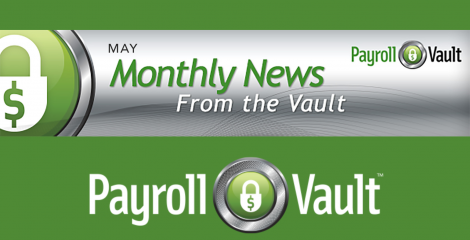
Families First Coronavirus Response Act
News Brief
APR 01, 2020
The focus in this edition is the ongoing COVID-19 crisis and what employers need to know about it. Below we summarize the Families First Coronavirus Response Act as well as the Coronavirus Aid, Relief, and Economic Security Act, explain how the tax credit will reimburse employers for the costs of providing leave, and outline the COVID-19 guidance and resources we have available on the HR Support Center.
News Brief
Families First Coronavirus Response Act
The Families First Coronavirus Response Act (FFCRA) was signed into law on March 18, 2020 and goes into effect today, April 1.
The Department of Labor has provided additional guidance on the new law, which we strongly encourage employers to read. We also encourage you to see our COVID-19 guidance and resources on the HR Support Center, which you can find by searching COVID-19.
Summary
For certain circumstances related to COVID-19, employees will be eligible for:
• Up to two weeks of sick leave (full pay for self, 2/3 pay for family care) for illness, quarantine, or school closures
• Up to 12 weeks of Family and Medical Leave Act (FMLA) leave for school closures (10 days unpaid and then up to 10 weeks at 2/3 pay)
Effective Date of Law
The FMLA and Paid Sick Leave sections discussed below went into effect on April 1, 2020 and expire December 31, 2020. Leave benefits and payroll credits will not be retroactive.
Key Elements for Employers
• Payroll Tax Credit
• FMLA expansion
• Paid sick leave
• Documentation

Payroll Tax Credit
• Applies to both the emergency FMLA expansion and the emergency sick leave.
• Dollar for dollar credit for sick leave and paid FMLA wages against the employer portion of Social Security taxes.
• Refund is possible for amounts that exceed what is available as a credit.
• Limits on what can be claimed mirror the caps for what must be paid.
Emergency FMLA Expansion
Covered Employers
Employers with fewer than 500 employees are covered.
Covered Employees
Any employee who has been employed for at least 30 calendar days, though employers may be able to exclude employees who are health care providers or emergency responders. See our COVID-19 FAQ on the HR Support Center for details on how the FFCRA defines health care providers and emergency responders.
Covered Leave Purpose: To care for a child under 18 of an employee if the child’s school or place of care has been closed, or the childcare provider is unavailable, due to a public health emergency, defined as an emergency with respect to the coronavirus declared by a federal, state, or local authority.
Duration:
• Up to 12 weeks of job-protected leave.
Compensation:
• No pay for first 10 days of leave (other paid time off, and emergency sick leave under the FFCRA, may be applied).
• After 10 days, employers must pay two thirds of the employee’s regular rate of pay for the number of hours they would normally be scheduled to work, capped at $200/day and $10,000 total.
Reinstatement to Position after Leave:
The same reinstatement provisions apply as under traditional FMLA. However, restoration to position does not apply to employers with fewer than 25 employees if certain conditions are met:
• The job no longer exists because of changes affecting employment caused by an economic downturn or other operating conditions that affect employment caused by a public health emergency;
• The employer makes reasonable efforts to return the employee to an equivalent position; and
• The employer makes efforts to contact a displaced employee if anything comes up within a year of when they would have returned to work.
Emergency Paid Sick Leave
Covered Employers
Employers with fewer than 500 employees.
Covered Employees
All employees (no matter how long they have been employed), though employers may be able to exclude employees who are health care providers or emergency responders. See our COVID-19 FAQ on the HR Support Center for details on how the FFCRA defines health care providers and emergency responders.
Covered Leave Purposes:
1. When quarantined or isolated subject to federal, state, or local quarantine/isolation order;
2. When advised by a health care provider to self-quarantine (due to concerns related to COVID-19);
3. When experiencing symptoms of COVID-19 and seeking a medical diagnosis;
4. When caring for an individual doing #1 or #2 (2/3 pay);
5. When caring for a child whose school or place of care is closed due to COVID-19 (2/3 pay); or
6. When the employee is experiencing any other substantially similar condition (2/3 pay).
Duration of Leave:
• Full time employees are entitled to 80 hours of paid sick leave.
• Part time employees are entitled to sick leave equal to the number of hours worked on average over a typical two-week period.
Rate of Pay:
• Sick leave must be paid at the employee’s regular rate of pay for leave used for the employee’s own illness, quarantine, or care.
• Sick leave must be paid at two-thirds of the employee’s regular rate if taken to care for a family member or to care for a child whose school has closed, or if the employee’s childcare provider is unavailable due to the coronavirus.
• Pay is capped at $511/day and $5,110 total for reasons 1, 2, and 3 described above.
• Pay is capped at $200/day and $2,000 total for reasons 4, 5, and 6 described above.
Small Business Exemption
Employers with fewer than 50 employees may be eligible for an exemption from the childcare leave provisions if at least one of the three statements below are true:
• Providing leave would result in the small business’s expenses and financial obligations exceeding available business revenues and cause it to cease operating at a minimal capacity;
• The absence of the employee or employees requesting leave would entail a substantial risk to the financial health or operational capabilities of the small business because of their specialized skills, knowledge of the business, or responsibilities; or
• There are not sufficient workers who are able, willing, and qualified, and who will be available at the time and place needed, and these labor or services are needed for the small business to operate at a minimal capacity.
Documentation and Additional Guidance
Required FFCRA Poster
The Department of Labor (DOL) has released a mandatory employee rights poster for the FFCRA. It should be posted or distributed to employees electronically (via email or online portal) by April 1. More information on the requirements can be found here.
Enforcement of FFCRA
The DOL will not bring enforcement actions against employers for violations of the FFCRA prior to April 17, 2020, provided that the employer has made reasonable, good faith efforts to comply with the Act. You can read more about the brief non-enforcement period here.
Documentation Required to Substantiate Leave Payments
(From the IRS) An Eligible Employer will substantiate eligibility for the sick leave or family leave credits if the employer receives a written request for such leave from the employee in which the employee provides:
1. The employee’s name;
2. The date or dates for which leave is requested;
3. A statement of the COVID-19 related reason the employee is requesting leave and written support for such reason; and
4. A statement that the employee is unable to work, including by means of telework, for such reason.
In the case of a leave request based on a quarantine order or self-quarantine advice, the statement from the employee should include the name of the governmental entity ordering quarantine or the name of the health care professional advising self-quarantine, and, if the person subject to quarantine or advised to self-quarantine is not the employee, that person’s name and relation to the employee.
In the case of a leave request based on a school closing or child care provider unavailability, the statement from the employee should include the name and age of the child (or children) to be cared for, the name of the school that has closed or place of care that is unavailable, and a representation that no other person will be providing care for the child during the period for which the employee is receiving family medical leave and, with respect to the employee’s inability to work or telework because of a need to provide care for a child older than fourteen during daylight hours, a statement that special circumstances exist requiring the employee to provide care.
How to Apply for Tax Credits
The IRS has released DRAFT instructions on how to access and administer payroll tax credits. The draft document is available here. Employers should regularly check back at this link for the final instructions.
Guidance from the DOL on Administering FFCRA Leaves
We strongly suggest that employers read through the entire Questions and Answers document, so they have an understanding of how the leaves work. The following are some highlights from the updated guidance:
• These leaves are not available to employees with reduced hours, furloughed employees, or employees whose workplaces are closed. See questions 23-28.
• These leaves are not available to employees whose workplaces are closed due to a federal, state, or local shelter-in-place or stay-at-home orders, or due to business slowdowns. See question 23.
• These leaves (and payroll tax credit) are not retroactive. Employees are not entitled to pay under these leaves if they were absent or out of work (for any reasons) prior to April 1. See question 13.
• Both emergency paid sick leave (EPSL) and emergency Family and Medical Leave (EFMLA) can be taken on an intermittent basis in certain situations. See Questions 20-22 for explanations about when intermittent leave is allowed.
• Employees may not be required to use other forms of paid leave prior to or concurrently with EPSL or EFMLA. See questions 32 and 33.
• Employers should keep documentation to show that employees who received leave were actually in need of leave. The documentation requirements are outlined in IRS guidance as discussed above. See Questions 15 and 16.
How to Pay for Leave Required by Families First Coronavirus Response Act
To take immediate advantage of the paid leave credits, businesses can retain and access funds that they would otherwise pay to the IRS in payroll taxes. If those amounts are not sufficient to cover the cost of paid leave, employers can seek an expedited advance from the IRS by submitting a streamlined claim form that will be released soon.
We know that for many of our clients, business slowdowns related to the spread of COVID-19 have made it hard to imagine how they could bear any additional expenses. We encourage anyone with these concerns to read the linked announcement carefully.
The full announcement can be found here: Treasury, IRS, and Labor Announcement on FFCRA Implementation.
COVID-19 Resources on the HR Support Center
We're keeping up with the latest COVID-19 news as well as state and federal efforts to assist employers and employees during this crisis. Search COVID-19 on the HR Support Center to find all our guidance and resources, including letters, forms, FAQS, news alerts, and policies.
Coronavirus Aid, Relief, and Economic Security Act (CARES Act)
On Friday, March 27, the President signed the Coronavirus Aid, Relief, and Economic Security Act (CARES Act). The new law is a $2 trillion economic stimulus package designed to repair the economic damage caused by COVID-19 and provide additional protection to individuals and businesses who may lose income due to the pandemic. While most of the act pertains to direct payments and loans, there are some sections that affect employers.

Providing Alternatives to Closure and Layoffs
The CARES Act gives employers the following options and benefits, which may allow them stay open and keep more people employed:
• Small businesses may be eligible for emergency grants of up to $10,000 to cover immediate operating costs.
• The Small Business Administration (SBA) may provide loans of up to $10 million per business; any portion of that spent to pay employees, keep workers on payroll, or pay for rent, mortgages, or existing debt could be forgiven, provided workers remain employed through the end of June.
• Small businesses with existing SBA loans may have up to six months of payments waived.
• Businesses that have experienced a decline in gross receipts of 50% as compared to the same quarter of 2019 or that have been fully or partially shutdown by order may be eligible to receive a refundable tax credit for 50% of qualified employee wages up to $10,000 per employee. This is unrelated to the dollar-for-dollar payroll tax credit that can be taken for FFCRA leaves.
• Businesses may defer payment of employer payroll taxes imposed between the enactment of this law and December 31, 2020 with half of the deferred taxes due by December 31, 2021 and the rest due by December 31, 2022. This is unrelated to the dollar-for-dollar payroll tax credit that can be taken for FFCRA leaves.
We are unable to advise on these topics as they are outside the scope of our expertise. We encourage you to follow the IRS Coronavirus Tax Relief page and the SBA Coronavirus Loan Resources page, as well as consult with your tax professional or financial advisor. Detailed guidance on how to access these financial resources should be coming soon from those sources.
Impact on Unemployment Insurance
The act increases the length of time someone can be on unemployment benefits to a maximum of 39 weeks. In many states, this will be an increase of 13 weeks of benefits. The act also adds $600 to the weekly amount an individual would usually receive. Independent contractors may be eligible for benefits under this expansion. While these unemployment benefits are generous, employers should still consider their options and incentives under the CARES Act mentioned above before making decisions about reduced hours, furloughs, or layoffs.
Employees who experience reduced hours, furloughs, or layoffs should be encouraged to file for unemployment insurance as soon as possible. We recommend that both employers and employees visit their state’s unemployment insurance department website and track local and state news, as departments across the country are updating their rules to facilitate displaced workers during this time.










